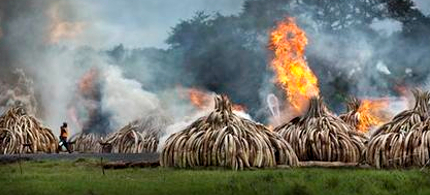Kenya Burns Huge Pile of Ivory Tusks to Protest Poaching
ANIMAL RIGHTS - VEGETARIANISM, 2 May 2016
Tom Odula, Associated Press – Reader Supported News
Kenya’s president set fire Saturday [30 Apr 2016] to 105 tons of elephant ivory and more than 1 ton of rhino horn, believed to be the largest stockpile ever destroyed, in a dramatic statement by this East African country against the trade in ivory and products from endangered species.
Uhuru Kenyatta put a flame to the biggest of 11 pyres of ivory tusks and one of rhino horn in a chilly afternoon. Overnight torrential rains had threated to ruin the event but stopped midday leaving a mud field around the piles inside Nairobi National Park.

A worker carries spray bottles of gel fuel to help the burning as he walks past pyres of ivory that were set on fire in Nairobi National Park, Kenya, Saturday, April 30, 2016. (photo: Ben Curtis)
“A time has come when we must take a stand and the stand is clear … Kenya is making a statement that for us ivory is worthless unless it is on our elephants,” Kenyatta said.
The stacks of tusks represent more than 8,000 elephants and some 343 rhinos slaughtered for their ivory and horns, according to the Kenya Wildlife Service.
Kenya will push for the total ban on trade in ivory at the 17th meeting of the Convention on International Trade of Endangered Species to be held in South Africa later this year, said Kenyatta.
The pyres were fueled with about 20,000 liters of jet fuel and oxygen, said Robin Hollister, the event’s fire master, as a thick plume of white smoke billowed over the yellow flames consuming the ivory. Hollister earlier said it’s not known how long the fire will take because the burning of such a quantity is unprecedented.
Kenya decided to destroy the ivory instead of selling it for an estimated $150 million. Some critics had suggested that the money raised from the ivory sales could be used to develop Kenya and protect wildlife. But Kenyatta said that Kenya wants to make the point that ivory should not have any commercial value.
Others said the burning will not end the killing of elephants because international gangs take advantage of Kenya’s porous borders and corruption to continue the illegal trade.
Kenya Wildlife Service chairman and renowned paleoanthropologist and conservationist Richard Leakey said the burning of the ivory should encourage African countries to support a ban in ivory trade. He said a group of countries which is advocating for the sale of ivory in the continent should be ashamed.
“We will burn ivory and we hope every country in the globe will support Kenya and say never again should we trade ivory,” Leakey said.
Africa had 1.3 million elephants in the 1970s but has only 500,000 today.
The elephant populations worst hit by poaching are in Tanzania, Gabon, Cameroon, Central African Republic, Mozambique, Republic of Congo and Congo. The years 2011, 2012 and 2013 witnessed the highest levels of poaching since a poaching crisis in the 1980s, according to Kenya’s Wildlife Service.
Cameroon said it burned over 3.5 tons of tusks earlier in April as a statement against poaching.
Central Africa’s forest elephants have declined by two-thirds between 2002 and 2012. Most of the remaining forest elephants are in Gabon and are under threat from armed groups, said Gabon’s President Ali Bongo Ondimba, who attended Saturday’s burning. He vowed to stop the decline of the species.
“To all the poachers, to all the buyers and foreign traders, your days are numbered,” said Ondimba. “We are going to put you out of business and the best thing to do is to retire now.”
Go to Original – readersupportednews.org
DISCLAIMER: The statements, views and opinions expressed in pieces republished here are solely those of the authors and do not necessarily represent those of TMS. In accordance with title 17 U.S.C. section 107, this material is distributed without profit to those who have expressed a prior interest in receiving the included information for research and educational purposes. TMS has no affiliation whatsoever with the originator of this article nor is TMS endorsed or sponsored by the originator. “GO TO ORIGINAL” links are provided as a convenience to our readers and allow for verification of authenticity. However, as originating pages are often updated by their originating host sites, the versions posted may not match the versions our readers view when clicking the “GO TO ORIGINAL” links. This site contains copyrighted material the use of which has not always been specifically authorized by the copyright owner. We are making such material available in our efforts to advance understanding of environmental, political, human rights, economic, democracy, scientific, and social justice issues, etc. We believe this constitutes a ‘fair use’ of any such copyrighted material as provided for in section 107 of the US Copyright Law. In accordance with Title 17 U.S.C. Section 107, the material on this site is distributed without profit to those who have expressed a prior interest in receiving the included information for research and educational purposes. For more information go to: http://www.law.cornell.edu/uscode/17/107.shtml. If you wish to use copyrighted material from this site for purposes of your own that go beyond ‘fair use’, you must obtain permission from the copyright owner.
One Response to “Kenya Burns Huge Pile of Ivory Tusks to Protest Poaching”
Read more
Click here to go to the current weekly digest or pick another article:
ANIMAL RIGHTS - VEGETARIANISM:
I hate this. It first of all means that these precious animals died for nothing. Second, due to supply and demand, the price will go up, meaning even more incentive for this slaughter. We need surveillance drones HERE not in war zones. Let these poachers have no safe zones or hiding places. A better plan would be to gradually have sold this booty to relatively responsible parties and use the money for anti-poaching practices, including buying the drones!